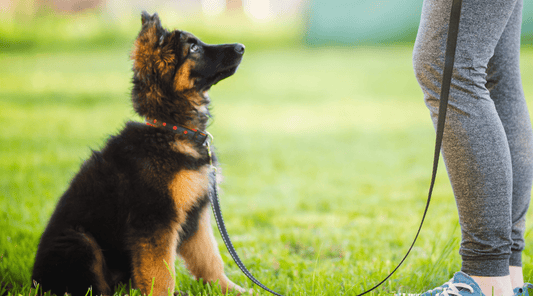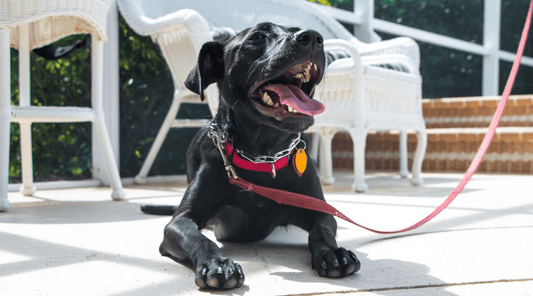
Why Do Dogs Eat Dirt: The Secret Behind Their Soil Obsession
Dawn Miller Apr 22, 20254 Minute ReadWondering why dogs eat dirt? So, did I.
Last week, I caught Bruno with his face halfway into my raised garden bed. Again. Fortunately, my tomatoes, peppers, and squash plants were still waiting for me in the greenhouse.
He looked up, dirt on his nose and paws, and wagged his tail like he just won a prize. If he could talk, I swear he would've said, “You grew this dirt just for me?”
It wasn’t the first time, and judging by the crater-sized hole he’d started under the maple tree, it won’t be the last. So I did what any curious dog mom with three big pups and a compost obsession would do—I dug into the reasons why dogs eat dirt. (Pun intended.)
Long story short, it’s a little weird. But not that weird. There are dangers. And most importantly, you can fix it.
The Wild Instinct Behind Dirt Snacking
As a person who has grown at least some of her own food for a while now, I've never been afraid to get my hands dirty—or eat a carrot without peeling it (washed, of course). But I know that dirt is well, dirty, and gross to a lot of people. I mean, it's not something anyone would intentionally eat—including me.
Except some dogs do. Today, we call this condition "Pica", which is a condition in which people (or dogs) intentionally eat non-food items. Pica in dogs is quite common.
In the wild, canines don't have multivitamins or vet-formulated kibble. So if their bodies were lacking something—like iron, calcium, protein, or even fiber—they’d go digging for it.
Fun fact, most dogs actually love root vegetables like carrots, potatoes, and sweet potatoes. They're a sweet treat. In the wild, root vegetables and tubers are a natural part of many dogs' diets.
That instinct doesn't necessarily go away. Whether Bruno thinks he smells a Japanese sweet potato I missed during harvest last year or he's really just in it for the dirt minerals, he's doing what his body is telling him to do.
Today’s pups? Same instincts.
But there's a bit more to it than that. And some are troubling!
Why Do Dogs Eat Dirt? (Top Reasons)
1. Nutritional Deficiencies
Dogs missing key minerals like iron, calcium, or zinc might seek them out in soil. If they’re not getting enough from food, they may try nature’s pantry to fill in the gaps.
My K9s' ancestral wolves and wild dogs are scavengers, not just predators. They know how to find food and will eat things they shouldn't if they're not getting enough or the right balance of canine nutrition.
2. Tummy Troubles
Some pups try to eat dirt when they feel nauseous or have other digestive issues. It can temporarily soothe the gut—until it doesn’t. In fact, until recently, a clay called Kaolin was a common ingredient in anti-diarrhea medicine for humans, and still is for dogs. It's believed that the clay absorbs some of the excess liquid in the gut, helping to ease the condition.
3. Boredom
A bored dog is a creative dog. And dirt? It’s cheap, plentiful, and fun to fling. If you have stray cats, squirrels, lizards, or other critters in the yard, it may also have their scents on it, making it a bit of a nose game as they track the scent.
4. Anxiety in Dogs
Stress-eating isn’t just for humans. Dogs can't reach for a bag of cheesy chips like we can when they feel overwhelmed. So, dirt can be a target, especially if it smells interesting.
5. Disease
Your dog could have a medical issue that's making it hard for them to absorb, process, or use calcium, iron, or something else. Eating dirt may be a way of getting extra nutrients.
6. Insufficient Protein
Kibble is around 18% protein, but most active and muscular dogs need more than that. Dirt isn't just dirt. It's often full of protein-rich food like earthworms and moles. These may be the actual target of this dirt obsession.
When Dirt Gets Dangerous
If your dog nibbles dirt now and then, it’s usually not a big deal. But if it becomes a daily ritual or includes rocks, plastic, toys, or mulch, it's time to pay closer attention.
What to watch for:
- Vomiting or diarrhea
- Worms or parasites
- Constipation or blockages
- Lethargy
- Drooling or lip-smacking
If you see any of these signs, call your vet. Some types of soil can contain chemicals, toxins, pesticides, herbicides, or sharp debris that aren’t dog-friendly. So, this isn't a habit you want to encourage.
How to Stop the Dirt Buffet
1. Don't Reward It
Be careful not to accidentally provide positive reinforcement that makes the habit worse. Laughing, praising, using a baby voice to chastise them, or giving them a tasty dog treat while they're digging can all be interpreted as approval by a dog. The activity becomes rewarding.
Positive reinforcement is powerful. It's critical to learn how to use reward-based training to teach good dog habits, not potentially harmful ones.
2. Redirect with Better Chews
Give them something better than dirt. Long-lasting dog bones are the perfect distraction—and way safer. My crew loves K9 Connoisseur’s marrow-filled bones. They’re nutrient-dense and satisfy that urge to chew and forage.
3. Upgrade Their Diet
Feeding a balanced, high-protein diet can reduce cravings for weird things. When in doubt, keep snacks simple.
Look for single-ingredient dog treats, like K9 Connoisseur’s beef lung bites. They're the best treats for dogs with sensitive stomachs. And let’s face it, these roasted organ meat treats smell a whole lot better than compost.
4. Offer Mental Stimulation
Bored dogs eat dirt. Smart dogs play sniff games, chase balls, or work through a food puzzle like a marrow-filled bone. They get bored just like we do when we have nothing to do.
Chewing on dog bones is a natural stress-reducer and boredom-buster in dogs. So if stress or boredom are part of the problem (and it usually is), a grass-fed dog bone sure can do the trick.
You can even try a mini training session. Just 5-10 minutes a day with a handful of treats can tire out their brain and body.
5. Train Your Dog
Dog training isn't just about having a well-adjusted pup. When you train with positive reinforcement, you strengthen your bond. You're helping your dog understand how the world works—in their favor, and yours. They get dog treats and praise for following dog commands. That's a win-win!
A well-trained dog has a sense of structure in its life that may cause it to feel less anxious or uncertain about its environment. It can stop excessive barking and destructive chewing because those behaviors are no longer rewarded.
Being calm and well-behaved earns treats instead.
Dog experts believe dogs can learn over 120 distinct dog commands. From sit to go potty to let's go, there are so many dog commands you'll find useful every single day.
Want to find out if positive reinforcement dog training can help you address behavioral challenges in your dog? Try the 7-Day Dog Training Challenge. You'll be amazed how fast you can teach your dog useful skills with high-value treats and praise.
Spoiler: they want the beef.
Available On:


Disclosure: This article may contain affiliate links, which means we may earn a small commission if you make a purchase through these links—at no extra cost to you. We only recommend products we trust and believe will benefit you and your K9.



